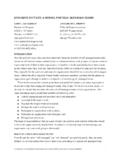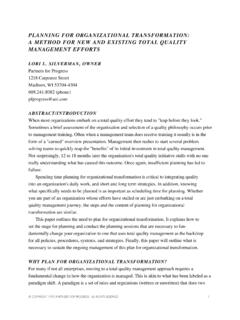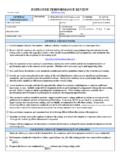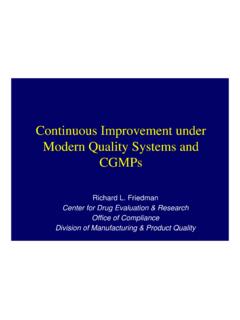Transcription of COACHING PROCESS IMPROVEMENT TEAMS
1 COPYRIGHT 1991 PARTNERS FOR PROGRESS AND FULLER & PROPST ASSOCIATES. ALL RIGHTS PROCESS IMPROVEMENT TEAMSLORI L. SILVERMANP artners for Progress1218 Carpenter StreetMadison, WI 53704, L. PROPSTF uller & Propst Associates41W202 Whitney RoadSt. Charles, IL 60175, I don't understand it. We've had these TEAMS for months and nothing's happened. Our TEAMS are floundering and we don't know what to do. We tried to help our TEAMS but they resented our suggestions. Some people even quit. Put a group of people in a room with a problem to solve. Give them a basic method for problemsolving and they will solve the problem. Right? Not always. So what is needed for TEAMS to besuccessful in their problem-solving efforts?When a company integrates a total quality management approach into its day-to-day andstrategic operations, it tends to stumble onto the answers to this issue.
2 To be successful, processimprovement TEAMS ( , TEAMS of employees of cross-functional and multilevel representation)that are put together to solve problems need:1 . To be composed of the appropriate individuals those who work in the work processwhere the problem is occurring, and customers and suppliers to that work PROCESS ;2. team members who have been exposed to the seven basic QC tools and TEAMS skills;3. To be given real problems to solve, not solutions to implement;4. A problem-solving methodology that investigates root causes based on data, before movingthe team to potential solutions and standardization of results;5. An approach to building a team environment in which team members have been empoweredto solve the problem within stated parameters and understand their roles and COPYRIGHT 1991 PARTNERS FOR PROGRESS AND FULLER & PROPST ASSOCIATES.
3 ALL RIGHTS , the problem situation, and the team s ground rules for working together;and6 . To have been provided with the services of an internal/external consultant who has beentrained in the above as well as how to coach the team through the PROCESS of problemsolving and how to build a team . This is especially necessary when team members have nothad the opportunity to utilize a problem-solving methodology on a regular basis and havenot had to solve problems in a team -based paper focuses on two of these areas: a problem-solving methodology called the 7-StageProblem-Solving PROCESS , based on the QC Story (1); and an approach for COACHING a processimprovement team through this methodology and its interactions as a team . This paper assumesthat the team has received the appropriate training, that the right members are on the team , and thatthe team has a common understanding of its charter (what others think it is to do), its mission(purpose and scope of its efforts), its ground rules, and individual roles and SOLVING VS.
4 CONTINUAL IMPROVEMENTB efore discussing these two areas in more detail it is important to distinguish between problemsolving and continual IMPROVEMENT . Problem solving is the action(s) taken to get rid of anexisting specific, undesirable effect(s). There are generally two types of problems: too much ofsomething with a need to decrease or eliminate; or too little of something with a need to of these two types of problems include reduction of a particular item ( , expenses),elimination of the occurrence of a particular item to zero ( , customer complaints), or increasinga particular item ( , sales or market share). Continual IMPROVEMENT is the action(s) taken tooptimize a specific characteristic or set of characteristics even though performance of thecharacteristic(s) might be acceptable to the customer.
5 The 7-Stage Problem-Solving PROCESS worksbest for the types of problems described here. It does not as readily apply to continualimprovement opportunities. (See the book, Critical SHIFT: The Future of Quality in OrganizationalPerformance for a systematic approach to continual IMPROVEMENT .)7-STAGE PROBLEM-SOLVING PROCESSThe 7-Stage Problem-Solving PROCESS has been adapted from the QC Story to reflect thephilosophy of W. Edwards Deming. This adapted method continues to embody a number ofquality concepts found in the QC Story approach:1 . The use of data to understand problems, make decisions, and test theories;2 . Stratification of data to identify root cause(s);3 . Solutions focused on curing root causes rather than treating symptoms;4 . Standardization of the problem solution; and COPYRIGHT 1991 PARTNERS FOR PROGRESS AND FULLER & PROPST ASSOCIATES.
6 ALL RIGHTS . Utilization of the Shewhart (Plan-Do-Check-Act) Cycle, both at the macro (overall sevenstages) and micro (within the stages) overview of this method is shown in Figure 1, the 7 Stage Problem Solving stage in the 7-Stage Problem-Solving PROCESS is explained here in more detail before thecoaching framework that supports its success is explained. Specifically, the following informationis outlined for each stage: The purpose of the stage; What the team will need to have to complete the stage; What the team needs to do during this stage to assure its completion; and What the team will want to have accomplished before proceeding on to the next stage of theproblem-solving 1: Identify the ProblemThe purpose of Stage 1 is to establish the importance of the problem as a basis for checking lateron to see if the problem is solved.
7 Understanding the importance of the problem may impact theresources needed to solve it. For example, is the problem serious enough to warrant theexpenditure of time and/or money that will be needed to solve the problem? The team also needs toestablish early on how it will know if the problem has been solved. This helps the team understandthe features that the solution must embody, as well as the data that will need to be collected, bothon the initial state of the problem and its changed state. To begin, the team will need: A team charter; A problem to work on; and Data on the behavior of the data, the team should first state the undesirable effects of the problem such as customercomplaints, loss of customers, higher costs, or unsafe working conditions. After determiningthese, the team should further explore these effects.
8 For example, what are the effects of unsafeworking conditions? Are people quitting as a result? Are they not doing a thorough job so they canleave the unsafe area sooner? What could be other effects? Could someone get killed?The team should continue this questioning approach until the effects are thoroughly understoodand documented. Often a team will begin by stating the problem as an answer or as aninterpretation of the effects. It takes perseverance to reverse direction to find the understanding the undesirable effects of the problem the team must establish the focus ofthe problem. If the problem is large, the team may decide to work on the problem in smallerchunks. A problem that is too big may be intimidating even impossible to solve. If the decisionis to focus only on limited aspects of the problem, the team can always return to bigger issues in a COPYRIGHT 1991 PARTNERS FOR PROGRESS AND FULLER & PROPST ASSOCIATES.
9 ALL RIGHTS 1: 7-Stage Problem-Solving ProcessInputs StageOutputsStage 3:Uncover the Cause(s)Stage 2: Investigatethe ProblemStage 1:Identify the ProblemMetrics for monitoringPlan (milestones)Resource requestsData on behavior of problemDeeper understanding of initial problem statementProcess knowledgeData about how the problem behavesTeam missionKnown problemData about the problemSpecific problem statementStratified dataImpact of problem on customers and suppliersDeeper understanding of initial problem statementMain cause(s) of the problemUnderstanding of cause systemStage 6:Eliminate the Cause(s) PermanentlyStage 5:Confirm the Effectiveness of the ActionStage 4:Take Action on the Main Cause(s)Plan of actionLimited test of solutionDecision on solution effectivenessOrganizational knowledgeMain cause(s) of the problemProcess knowledgeData on initial behavior of problemResults of testComparison of new vs.
10 Old problem behaviorDecision on solution effectivenessSystem for ongoing monitoringInstitutionalized changeStage 7:Review Activities and Plan Next StepsNew directions for teamSuggested improvements to the 7 StagesTeam missionData on new current stateExperience using problem solving processResults of testFlowchart of work processProcess theorySpecific problem statementOrganizational knowledgeInstructions for the jobNew job standardsProcess knowledgePlan of actionObservations from trial COPYRIGHT 1991 PARTNERS FOR PROGRESS AND FULLER & PROPST ASSOCIATES. ALL RIGHTS problem-solving cycle. Any constraints such as budget or time should be brought to theteam's attention at this point as they may help in determining the focus of the the team has identified the scope of the problem, it is important for it to determine howprogress will be measured.









